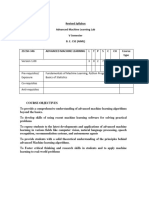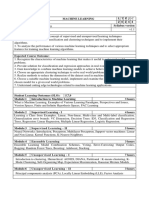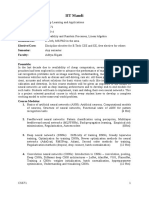0 ratings0% found this document useful (0 votes) 26 views3 pagesMachine Learnig Syllabus
Nirma university M TECH MLDL machine learnig
Copyright
© © All Rights Reserved
We take content rights seriously. If you suspect this is your content,
claim it here.
Available Formats
Download as PDF or read online on Scribd
IRMA UNIVERSITY
Institute: Institute of Technology
‘Name of Programme: | MTech CSE (Cyber Security)
‘Course Cod 6CS401
‘Course Tith Machine and Deep Learning |
‘Course Type: ‘(Corel “| Value Added Course /(1 Department Elective /
1 Institute 1 University Elective/ © Open Elective /
Any other)
‘Year of Introduction: [2022-23
L_|T | Practical Component | C
Lew | Pw [Ww [Ss
3[-[ 2 -[-[-[4
Course Learning Outcomes (CLO):
At the end of the course, the student will be able to —
1.
make use of machine leaming and deep lea
problems in applicable domains
ig techniques to solve (BL3)
2. appraise the need of machine learning and deep learning (BLS)
3. evaluate variety of machine leaming algorithms for appropriate (BLS)
applications.
4, adopt different deep learning algorithms appropriate to solve problems in (BL6)
various domains
Syllabus: Total Teaching hours: 45
Syllabus Teaching
hours
Unit Introduction: Motivation and Applications, importance of Data 02
Visualization, Basics of Supervised and Unsupervised Learning,
Unsupervised Learning 03
Clustering: Hierarchical Agglomerative Clustering, k-means
Algorithm, Self-Organizing Maps
Unit-III Supervised Learning 12
Regression Techniques: Basic concepts and applications of
Regression, Simple Linear Regression — Gradient Descent Method,
Multiple Linear Regression, Non-Linear Regression, Linear
Regression with Regularization, Hyper-parameters tuning, Loss
Functions, Evaluation Measures for Regression Techniques
Classification Techniques: Naive Bayes Classification, Fitting
Multivariate Bemoulli Distribution, Gaussian Distribution and
Multinomial Distribution, K=Nearest Neighbours, Decision trees.
Support Vector Machines: Hard Margin and Soft Margin, Kernels
and Kernel Trick, Evaluation Measures for Classification Techniques
UnitIV Artificial Neural Networks: Perceptron Leaming, Feed Forward 10
‘Neural Networks, Back-propagation, Unstable and vanishing Gradient
Problem
de�Unit-V
Unit-VI
Unit-VIT
Convolutional Neural Networks: Convolution & Pooling, Dropout,
Batch Normalization, State-of-the-art CNNs
Transfer Learning & Domain Adaptation: Transfer Learning
Scenarios, Applications of Transfer Leaming, Transfer Leaning
Methods, Fine Tuning and Data Augmentation, Supervised, Semi
Supervised and Unsupervised Deep Learning
Sequence Models: Recurrent Neural Networks (RNN), Language
Modelling, Long-Short Term Memory Network, Gated Recurrent
Unit, Biedirectional RNN, Applications of Sequence Models
Miscellaneous: Linear Discriminant Analysis, Auto encoders and
Stacked Auto encoders, Generative Adversarial Networks, Deep
03
09.
06
Reinforcement Learning
Self-Study:
Suggested
Readings!
References:
Suggested List of
Experiments:
The self-study contents will be declared at the commencement of
semester. Around 10% of the questions will be asked from self-study
contents
1, Tom Mitchell, Machine Learning, TMH
2. C. Bishop, Patter Recognition and Machine Learning, Springer
3. Kishan Mehrotra, Chilukuri Mohan and Sanjay Ranka, Elements of
Artificial Neural Networks, Penram International
4, Athem Ealpaydin, Introduction to Machine Learning, PHI
5. Ian Goodfellow, Yoshua Bengio, Aaron Courville, Deep Learning,
MIT Press,
6. Charu C. Aggarwal, Neural Networks and Deep Learning — A
Textbook, Springer
7. Adam Gibson, Josh Patterson, Deep Learning, O'Reilly Media, Ine.
8. Hastie, T., Tibshirani, R. and Friedman, J. The Elements of Statistical
Leatning, Springer
sr. Title Hours
No.
1 Introduction to Python, Numpy, Sklearn and 02
Matplottib.
2 Implementation of K-means and Hierarchical 02
clustering algorithms.
3 Linear Regression with Regularization (without using 02
skleatn or equivalent library) and Simple and Multiple
Linear Regression with and without regularization
using Skleam.
4 Nalve-Bayes — Multivariate Bernoulli, Multinomial 02
and Gaussian using sklearn.
5 Decision Trees — 1D3, C4.5 using sklear, Support 04
‘Vector Classification and Regression with Grid Search
for Hyper-parameter tuning using skleam,
6 AND gate using Perceptron Learning (self 04
implementation). Ex-OR Gate/any other problem�*Marked as addi
using Backpropagation Neural Networks (self
implementation) and Sklearn.
Convolutional Neural Network on MNIST, Fashion
MNIST and CIFARIO datasets. Write code using (a)
Sequential Class (b) Model Class API
Use transfer learning for Image Segmentation &
Detection using Deep Networks.
Unsupervised MNIST
Build a language model using RNN. Write functions
to sample novel sentences and find the probability of
input sentence. Also, use Recurrent Neural Network
for Sentiment Analysis.
Reinforcement learning for game development.
jonal definitions for practice
04
04
04
02
06
























































